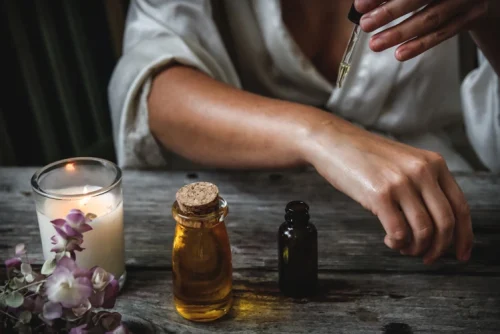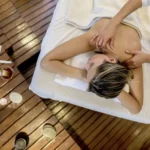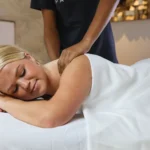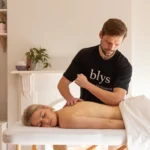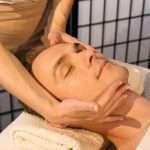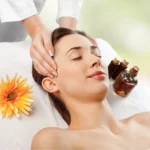Curious about abhyanga massage and what makes it such a cherished part of Ayurvedic tradition? Abhyanga is a deeply nourishing full-body oil massage that’s been practiced in India for thousands of years. Using warm herbal oils and rhythmic strokes, this therapeutic ritual enhances circulation, promotes lymphatic flow, calms the nervous system, and brings balance to body and mind. Whether used as part of daily self-care or a rejuvenating weekly ritual, abhyanga offers a powerful way to reconnect with your body, reduce stress, and support long-term health from the inside out.
Table of Contents
🌿What Is Abhyanga Massage
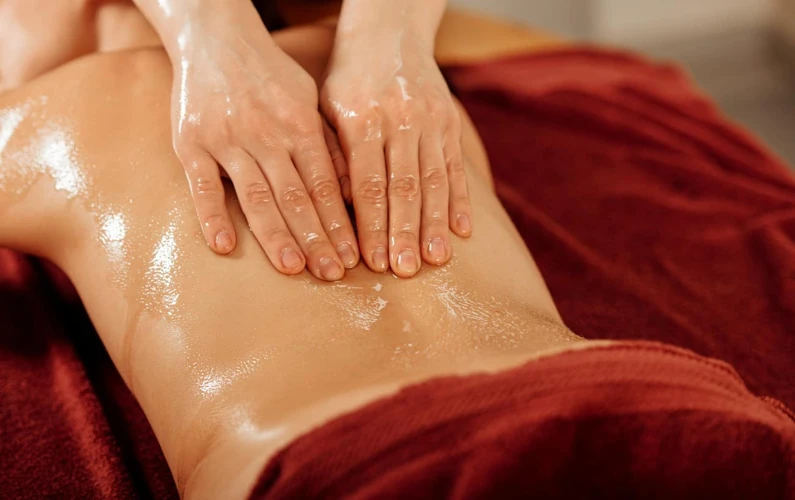
Abhyanga massage is a traditional Ayurvedic therapy that uses warm herbal oils and long, rhythmic strokes to gently massage the entire body. Often referred to as the “Ayurvedic oil massage,” this practice aims to restore balance between the body, mind, and spirit while enhancing overall wellness.
Rooted in centuries of Ayurvedic healing, abhyanga helps to:
- Improve circulation and lymphatic drainage
- Nourish and soften the skin
- Calm the nervous system
- Support the body’s detoxification processes
Abhyanga is typically performed in a warm, serene environment using oils tailored to your dosha (your unique Ayurvedic constitution). While some people enjoy it as a daily ritual, it’s commonly offered in a series of 4 to 6 sessions during Ayurvedic treatments or seasonal cleanses. Gentle yet deeply therapeutic, abhyanga is considered safe and beneficial for people of all ages and health levels.
Keep in mind that the specifics of a full-body abhyanga massage may vary depending on the therapist, the oils used, and your individual health needs.
History of Abhyanga Massage

Abhyanga massage is an ancient Ayurvedic practice that dates back to the Vedic period (1500–500 BCE) in India. It’s featured in classical Ayurvedic texts like the Charaka Samhita and Sushruta Samhita, where it was recommended as part of daily self-care (dinacharya) to promote health and longevity.
Traditionally performed with warm herbal oils, abhyanga was used to support detoxification, improve circulation and lymphatic flow, relieve muscle pain, and calm the nervous system. It was seen not just as a treatment, but as a way to maintain balance between body, mind, and spirit.
Today, abhyanga is practiced globally and remains one of the most valued Ayurvedic therapies for enhancing wellbeing, reducing stress, and supporting overall health naturally.
Benefits of Abhyanga Massage
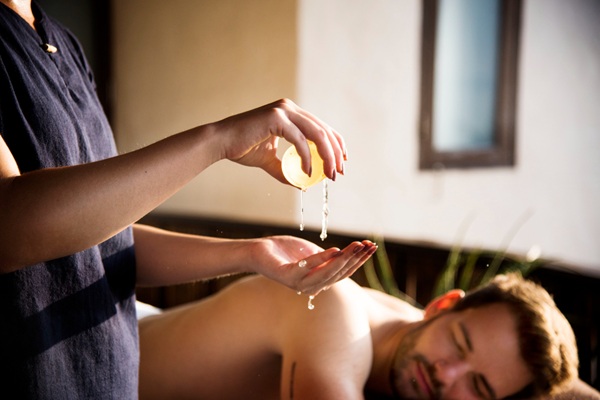
| Benefit | Description |
|---|---|
| Improves Circulation | Abhyanga massage helps to improve the circulation of blood and lymph in the body, providing essential nutrients to all the cells and organs, and removing waste products. |
| Nourishes the Skin | Abhyanga massage helps to nourish the skin, leaving it soft and supple. Natural oils used in the massage are quickly absorbed and penetrate deeply into the skin, improving its texture and appearance. |
| Relieves Stress | Abhyanga massage is a form of Ayurvedic self-care that helps to relax and calm the body, relieving tension and stress. The gentle and rhythmic strokes help to reduce cortisol levels and promote feelings of peace and harmony. |
| Promotes Sleep | Abhyanga massage helps to reduce insomnia and improve the quality of sleep. The gentle and soothing massage helps to relax the body and mind, allowing for restful sleep. |
| Reduces Pain | The gentle strokes of an Abhyanga massage can help to reduce muscular pain, stiffness and tension in the body. Natural oils used in the massage help to lubricate the joints, providing relief from pain and discomfort. |
| Increases Immunity | Abhyanga massage helps to strengthen the immune system by stimulating the lymphatic system and improving circulation. This helps to remove toxins from the body and increases resistance to disease. |
Abhyanga massage is a great way to relax, reduce stress and improve overall wellbeing. Practicing Abhyanga massage regularly is a simple and effective way to stay healthy and can be done easily from the comfort of your own home.
Principles of Abhyanga Massage
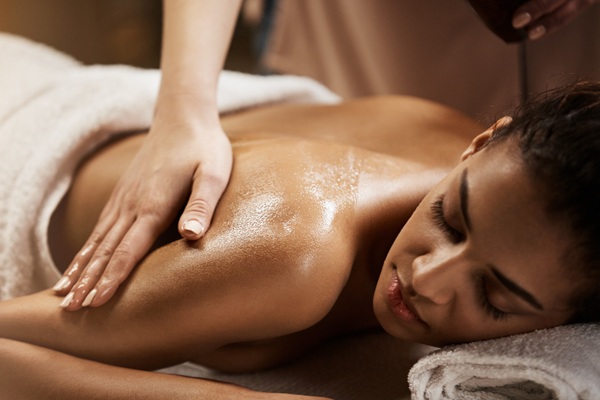
| Principle | Explanation |
|---|---|
| Tapping | Abhyanga massage incorporates the tapping technique, which involves tapping on the body with the hands and fingers to help relax tense muscles and improve circulation. |
| Stroking | The therapist performs a gentle, long-stroke massage to help stimulate the circulation of blood and lymphatic fluids and to promote relaxation. |
| Circular Massage | The therapist uses their palms and fingertips to perform circular massage movements over the entire body, focusing on the areas that are tense or sore. |
| Kneading | The therapist uses their knuckles to knead the muscle tissue and help to work out knots and tension. |
| Friction | The therapist uses their fingertips to apply firm pressure to the muscle tissue, helping to relieve tightness and improve circulation. |
Abhyanga massage also incorporates the use of medicated oils, which helps to nourish and moisturize the skin, as well as to reduce inflammation and improve circulation. The therapist applies the oil to the body with their hands and works it into the skin using the techniques mentioned above. The massage is finished off with a gentle steam to help further relax the body.
Types of Abhyanga Massage
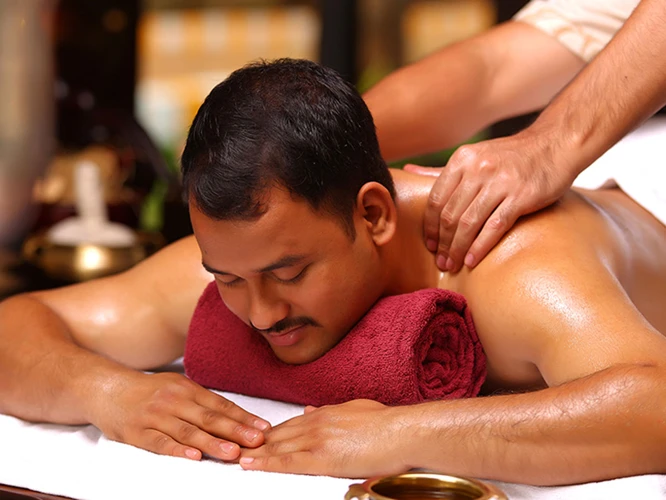
- Udvartana: This type of Abhyanga massage uses herbal powders to massage the body. It is believed to be beneficial in reducing excess fat, improving skin tone, and detoxifying the body.
- Ksheera Abhyanga: This massage uses milk to hydrate and nourish the skin. It is believed to be beneficial in reducing wrinkles and revitalizing the skin.
- Garshana Abhyanga: This type of massage uses a silk glove to exfoliate the skin. It is believed to be beneficial in removing dead skin cells, increasing circulation, and stimulating cell regeneration.
- Sarvanga Abhyanga: This massage uses warm oil and herbs to massage the entire body. It is believed to be beneficial in relieving stress, improving circulation, and promoting relaxation.
- Kati Abhyanga: This massage uses warm oil and herbal pastes to massage the back and neck. It is believed to be beneficial in relieving tension, improving posture, and reducing pain.
How to Prepare for an Abhyanga Massage
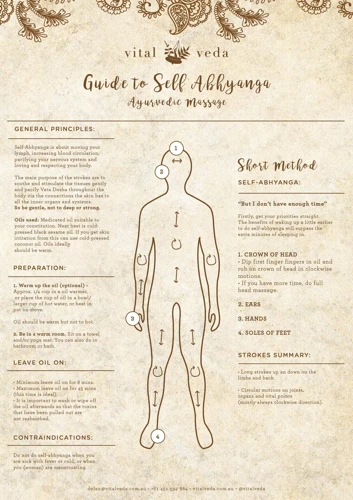
- Choose the Right Oil: Abhyanga massage is typically performed with warm oil, such as sesame or coconut, so it is important to select the right oil for your skin type. Consult your therapist or an Ayurvedic practitioner for the best oil for your body type.
- Take a Warm Shower: Taking a warm shower before the massage helps to open the pores and make the skin more receptive to the oil.
- Set a Relaxed Atmosphere: Setting a relaxed environment is essential for an effective Abhyanga massage. To do this, turn off your phone and any other distractions, light some candles or incense, and play some calming music.
- Wear Loose, Comfortable Clothing: You will be asked to remove your clothing for the massage, so it is important to wear something that is comfortable and easy to take off.
- Clear Your Mind: Spend a few moments before your massage to clear your mind and clear any negative thoughts that may be on your mind.
What to Expect During an Abhyanga Massage
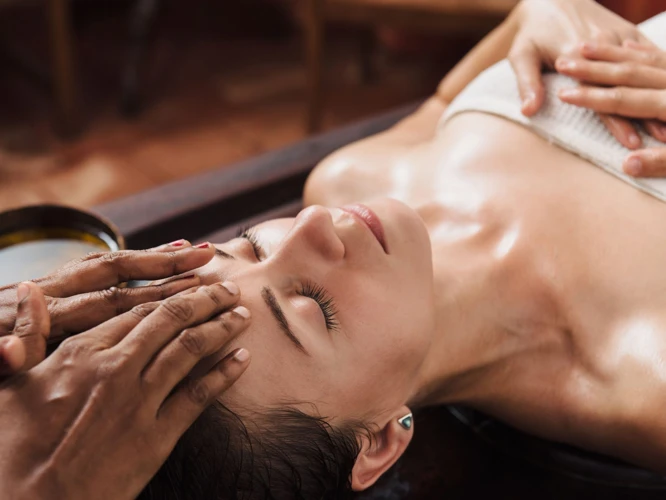
- Oil Application: Abhyanga massage is done with herbal oils. The oil used depends on your Ayurvedic dosha and is chosen to balance your constitution. The oil is then applied to your body in a rhythmic manner, using long strokes.
- Marma Stimulation: The massage also includes stimulating the marmas – the vital points within the body where energy channels flow. This helps to open up blocked energy channels and allow for a deeper flow of energy throughout the body.
- Ayurvedic Herbal Powder Massage: An Ayurvedic herbal powder massage may also be included as part of the Abhyanga massage. This powder is chosen to suit your individual needs and helps to soothe the body and mind.
- Shirodhara: Shirodhara is a part of Abhyanga massage where warm oil is poured over the forehead in a continuous stream. This helps to induce a deep state of relaxation and helps to balance the energy of the body and mind.
- Warm Towel Treatment: After the Abhyanga massage, warm towels are used to remove the oil from the body. This helps to relax the body and mind and allows for a deeper connection with the healing process.
How to Do Abhyanga Massage at Home
Abhyanga massage can easily be done at home with minimal supplies and the right technique. To begin, you will need an appropriate massage oil. Depending on your dosha type, you can choose from sesame, almond, or coconut oil. Warm the oil before beginning the massage. Start with your legs, and work your way up. Massage in circular motions, and focus on areas that feel particularly tight.
Once you have finished with the legs, move onto the arms and torso, using the same circular motions. Again, focus on any areas that feel particularly tight or tender. After the arms and torso, move onto the head. Using your fingertips, massage the scalp in gentle, circular motions.
Once you have finished with the massage, it is important to let the oil sit on the body for 15-20 minutes. This will allow the oil to penetrate the skin and work its magic. After this time, you can take a warm shower to rinse off the oil.
Abhyanga massage is an incredibly powerful tool that can be used to promote both physical and mental wellbeing. With the right technique, you can easily enjoy this ancient Ayurvedic practice in the comfort of your own home.
❓ Frequently Asked Questions
🙋 Is Abhyanga Massage Suitable for Everyone?
Yes, abhyanga massage is generally suitable for people of all ages and genders. It can be tailored to meet individual needs, whether you’re managing specific health concerns like high or low blood pressure, arthritis, headaches, chronic fatigue, or depression, or simply seeking a calming and nourishing experience. The pressure and oil type can be adjusted to be gentle or more invigorating depending on your constitution and preferences.
📅 How Often Should You Get an Abhyanga Massage?
The ideal frequency depends on your dosha type, health status, and lifestyle. In general, once a week is recommended for maintaining balance and wellbeing. However, individuals dealing with chronic pain, high stress, or specific imbalances may benefit from more frequent sessions—even daily during certain Ayurvedic therapies. For the best results, consult with a certified Ayurvedic practitioner.
⚠️ Are There Any Contraindications for Abhyanga?
While abhyanga is safe for most people, there are certain conditions where caution or avoidance is necessary:
- Pregnancy: Not advised in the first trimester
- Skin conditions: May aggravate active eczema, psoriasis, or rashes
- Open wounds or cuts: Massage should be avoided on broken skin
- Heart conditions: Use with caution in cases like congestive heart failure
- High fever or infection: Massage should be postponed during active illness
Always consult your healthcare provider or Ayurvedic therapist before starting if you have any underlying conditions.
🌿 What Oils Are Used in Abhyanga Massage?
The choice of oil is tailored to your Ayurvedic dosha—Vata, Pitta, or Kapha—and may vary based on the season and specific health needs. Commonly used oils include:
- Sesame Oil: Warming and grounding—best for Vata types
- Coconut Oil: Cooling and calming—ideal for Pitta types
- Mustard Oil: Stimulating and warming—suitable for Kapha types
- Almond Oil: Nourishing and gentle—tridoshic (balances all types)
Other oils like sunflower, jojoba, or medicated herbal oils may also be used. Oils are typically warmed before application to enhance absorption and therapeutic effect.
Final Thoughts
Abhyanga massage is more than just a relaxing treatment—it’s a time-tested Ayurvedic ritual designed to support whole-body wellness. Whether you’re seeking better sleep, less stress, improved flexibility, or just a moment of calm, abhyanga massage offers a simple yet powerful way to reconnect with yourself.
Best of all, it’s versatile: you can enjoy it as a luxurious treatment with a trained therapist or make it part of your regular at-home self-care routine. With its ability to be tailored to your unique needs and dosha type, abhyanga is a nourishing practice for anyone looking to boost physical and emotional wellbeing the Ayurvedic way.
References
- Kumar A, Kumar S, Agrawal A. Ayurvedic massage: a holistic approach towards health and wellbeing. Indian J Tradit Knowledge. 2011;10(3):360-369.
- Ayurvedic Medicine – In Depth
⚠️ Disclaimer:
This article is for informational purposes only and does not constitute medical advice. Always consult with a licensed healthcare provider or certified massage therapist before beginning any new treatment, especially if you have pre-existing health conditions or concerns.

